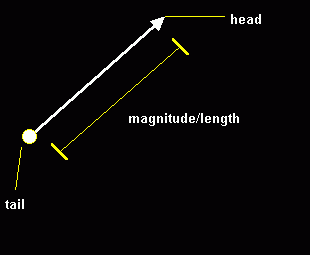
Vectors are
cool!!!
It's almost impossible to do graphics
programming without using vectors. Almost all math concerning 3d coding use
vectors. If you hate vectors, read on and you'll probably
love them more than
your girlfriend after you've finished reading this article. ;*)
What are
vectors?
First off, let me define 2 quantities: The SCALAR and VECTOR
quantities. Okay, scalar quantities are just values. One example of it is
Temperature. You say, "It's 40 degrees Celsius here", and that's it. No sense of
direction. But to define a vector you need a direction or sense. Like when the
pilot say's, "We are 40 kilometers north of Midway". So a scalar quantity is
just a value while a vector is a value + direction.
Look at the figure
below: The arrow(Ray) represents a vector. The
"Head" is its "Sense"(direction is not
applicable here) and the "Tail" is its starting point. The distance from head to
tail is called its "magnitude".

In this vector there
are 2 components, the X and Y component. X is the horizontal and Y is the
vertical component. Remember that "ALL VECTOR OPERATIONS ARE DONE WITH
ITS
COMPONENTS."
I like to setup my vectors in this
TYPE:
Type
Vector
x as
single
y as
single
End TYPE
The difference between the "sense" and
"direction" is that direction is the line the vector is located while sense can
go
either way on that line.
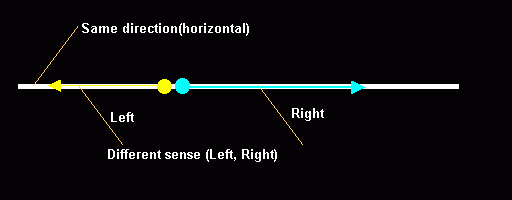
Definitions:
*|v| means that |v| is the
magnitude of v.
*Orthogonal vectors are vectors perpendicular to each
other. It's sticks up 90 degrees.

To get a vector between 2
points:
2d:
v = (x2 - x1) + (y2 - y1)
3d:
v = (x2 - x1) + (y2 - y1) + (z2 - z1)
QBcode:
vx = x2 -
x1
vy = y2 -
y1
vz = z2 -
z1
where: (x2-x1) is
the horizontal component and so on.
Vectors are not
limited to the cartesian coordinate system.
In polar
form:
v = r * theta
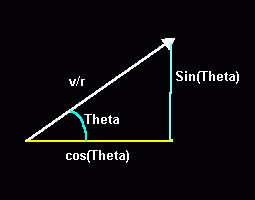
Resolving a vector
by its components
Suppose a vector v
has a magnitude 5 and direction given by Theta = 30 degrees. Where theta is the
angle the vector makes with the positive x-axis. How do we resolve this vectors'
components?
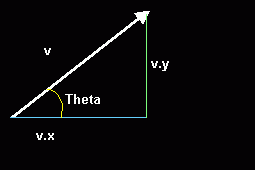
Remember the Polar to Cartesian
conversion?
v.x = cos(theta)
v.y
= sin(theta)
Let vx =
horizontal component
Let vy = horizontal component
Let Theta = Be the
angle
So...
v.x = |v| * cos(theta)
v.x = 5 *
cos(30)
v.x = 4.33
v.y = |v| *
sin(theta)
v.y = 5 * sin(30)
v.y =
2.50
What I've been showing you is a 2d vector. Making a 3d vector is just adding
another component, the Z component.
Type
Vector
x as
single
y as
single
z as
single
End TYPE
Operations on vectors needed in 3d
engines
1. Scaling a
vector(Scalar multiplication)
Purpose:
This is used to scale a vector by a
scalar value. Needed in the scaling of models and changing the velocity of
projectiles.
In equation:
v = v *
scale
In
qbcode:
v.x = v.x *
Scale
v.y = v.y *
Scale
v.z = v.z *
Scale
2. Getting the
Magnitude(Length) of a vector
Purpose:
Used in "Normalizing"(making it a unit vector) a vector.
More on this later.
Equation:
|V| = Sqr(v.x^2 + v.y^2 +
v.z^2)
QBcode:
Mag! = Sqr(v.x^2 + v.y^2 +
v.z^2)
3. Normalizing a
vector
Purpose:
Used in light sourcing, camera transforms, etc. Makes the vector a
"unit-vector" that is a vector having a magnitude of 1. Divides
the vector by its length.
Equ:
v =
v
-------
|v|
QBCode:
Mag! = Sqr(v.x^2 +
v.y^2 + v.z^2)
v.x = v.x /
mag!
v.y = v.y / mag!
v.z = v.z /
mag!
4.
The DOT Product
Purpose:
Used in many things like lightsourcing and vector
projection. Returns the cosine of the angle between any two vectors ( Assuming
the vectors are Normalized) . A Scalar.
The dot product is also called the
"Scalar" product.
Equ:
v.w = v.x* w.x + v.y* w.y + v.z*
w.z
QBCode:
Dot! = v.x* w.x + v.y* w.y + v.z*
w.z
Fun fact:
* 2
Vectors are orthogonal if their dot product is 0.
Proof: "What is the cosine
of 90?"
5. The CROSS
product
Purpose:
Used in lightsourcing, camera transformation, back-face culling, etc. The cross
product of 2 vectors returns another vector that is orthogonal to the plane that
has the first 2
vectors. Let's say we have vectors U and
F.
Equ:
U x F = R
QB code:
R.x = U.y * F.z - F.y * U.z
R.y
= U.z * F.x - F.z * U.x
R.z = U.x * F.y - F.x *
U.y
Fun facts:
* C is the vector
orthogonal to A and B.
* C is the NORMAL to the plane that includes A and
B. The cross-product of any two vectors can best be remembered by the
CRAMERS RULE on DETERMINANTS. Thought of it while
taking a bath. I'll tell you when I finish my matrix chapter.
*
The cross product is exclusive to 3d and its also called the "Vector"
product.
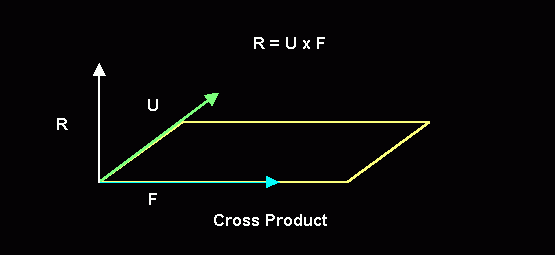
6. Vector
Projection
Purpose:
Used in resolving the second vector of the camera matrix (Thanks Toshi!). For vectors A and B...
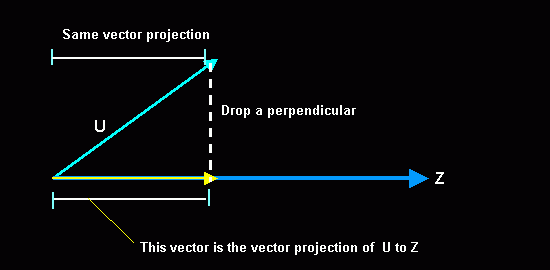
Equ:
U.Z *
Z
QB
code:
Let N = vector projection of U to Z. The vector parallel to Z.
T! = Vector.Dot(U,
Z)
N.x = T! * Z.x
N.y = T! *
Z.y
N.z = T! * Z.z
7. Adding
vectors
Purpose:
Used in camera and
object movements. Anything that you'd want to move relative to your
camera. Adding vectors is just the same as adding their components. Let A
and B be vectors in 3d, and C is the sum:
Equ:
C = A + B
C = (ax + bx) +
(ay + by) + (az + bz)
QBcode:
c.x = a.x +
b.x
c.y = a.y + b.y
c.z = a.z +
b.z
Now that Most of the
Math is out of the way....
Applications
I. WireFraming and BackFace culling
I
like to make use of types with my 3d engines.
For Polygons:
Type
Poly
p1 as
integer
p2 as
integer
p3 as
integer
end type
P1 is the first
vertex, p2 second and p3 third. Let's say you have a nice rotating cube composed
of points, looks spiffy but you want it to be composed of polygons(Triangles) in
this case). If we have a cube with vertices:
Vtx1 50, 50, 50
:x,y,z
Vtx2 -50, 50,
50
Vtx3 -50,-50,
50
Vtx4 50,-50,
50
Vtx5 50,
50,-50
Vtx6 -50,
50,-50
Vtx7
-50,-50,-50
Vtx8
50,-50,-50
What we need are connection points that define a face. The one below is a
Quadrilateral face(4 points)
Face1 1, 2, 3,
4
Face2 2, 6, 7,
3
Face3 6, 5, 8,
7
Face4 5, 1, 4,
8
Face5 5, 6, 2,
1
Face6 4, 3, 7,
8
Face1 would have vertex 1, 2, and 3
as its connection vertices.
Now since we want
triangles instead of quads, we divide each quad into 2 triangles, which would
make 12 faces. It' also imperative to arrange your points in counter-clockwise
or
clockwise order so that backface culling would work. In this case I'm
using counter-clockwise.
The following code divide the
quads into 2 triangles with vertices arranged in counter-clockise order.
Tri(j).idx will be used for sorting.
QBcode:
j =
1
FOR i = 1 TO
6
READ p1,
p2, p3, p4 'Reads the
face(Quad)
Tri(j).p1 =
p1
Tri(j).p2 =
p2
Tri(j).p3 =
p4
Tri(j).idx =
j
j = j + 1
Tri(j).p1 =
p2
Tri(j).p2 =
p3
Tri(j).p3 =
p4
Tri(j).idx =
j
j = j +
1
NEXT
i
To
render the cube without backface culling, here's the pseudocode:
1.
Do
2. Rotatepoints
3. Project
points
4. Sort(Not needed for cubes and other simple
polyhedrons)
5. Get Triangles' projected
coords
ie.
x1 =
Model(Tri(i).P1).ScreenX
y1 =
Model(Tri(i).P1).ScreenY
x2 =
Model(Tri(i).P2).ScreenX
y2 =
Model(Tri(i).P2).ScreenY
x3 =
Model(Tri(i).P3).ScreenX
y3 = Model(Tri(i).P3).ScreenY
6.
Draw
Tri
x1,y1,x2,y2,x3,y3,color
BackFace Culling
Backface
culling is also called "Hidden face removal".
In essense, it's a way to speed up your routines by NOT showing a polygon if
it's not facing towards you. But how do we know what face of the polygon is the
"right" face? Let's take a CD as an example, there are 2 sides to a particular
CD. One side that the data is to be written and the other side where the label
is printed. What if we decide that the Label-side should be the right side? How
do we do it? Well it turns out that the answer is our well loved NORMAL. :*) But
for that to work, we should *sequentially* arrange our vertices in counter or
clockwise order.
If you arranged your
polys' vertices in counter- clockwise order as most 3d modelers do, you just get
the projected z-normal of the
poly and check if its greater than(>)0. If
it is, then draw triangle. Of course if you arranged the vertices in
clockwise
order, then the poly is facing us when the Z-normal is
<0.
Counter-Clockwise arrangement of vertices:
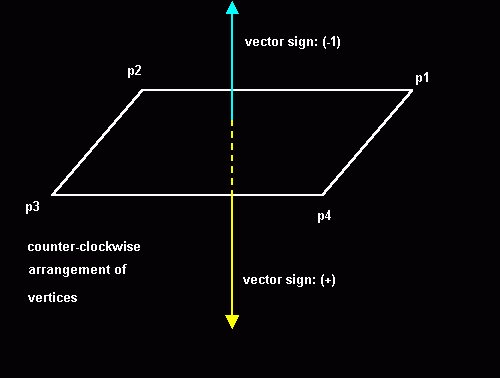
Clockwise Arrangement of vertices:
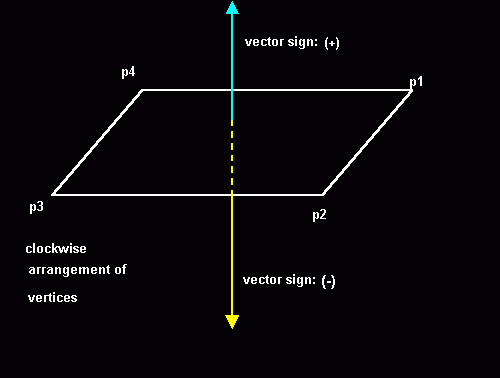
Since we only need the
z component of the normal to the poly, we could even use the "projected"
coords(2d) to get the z component!
QBcode:
Znormal = (x2 - x1) * (y1 - Y3) -
(y2 - y1) * (x1 - X3)
IF (Znormal > 0) THEN '>0 so
vector facing us
Drawpoly
x1,y1,x2,y2,x3,y3
end if
Here's the example file:
3dwire.bas
Sorting
There are numerous
sorting techniques that I use in my 3d renders here are the most
common:
1. Bubble sort
(modified)
2. Shell sort
3. Quick
sort
4. Blitz sort (PS1 uses this according to
Blitz)
I won't go about
explaining how the sorting algorithms work. I'm here to discuss how to implement
it in your engine. It may not be apparent to you (since you are rotating
a
simple cube) but you need to sort your polys to make your renders look
right. The idea is to draw the farthest polys first and the nearest last. Before
we could go about sorting
our polys we need a new element in our
polytype.
Type
Poly
p1 as
integer
p2 as
integer
p3 as
integer
idx as
integer
zcenter as
integer
end type
*Idx would be the index we use to sort the polys. We sort
via
IDX, not by subscript.
*Zcenter is the theoretical center of the
polygon. It's a 3d coord (x,y,z)
To get the center
of any polygon or polyhedra(model),you add all the 3 coordinates and divide it
by the number of vertices(In this case 3).
Since we only want to get the
z center:
QBcode:
Zcenter=
Model(Poly(i).p1)).z + Model(Poly(i).p2)).z +
Model(Poly(i).p3)).z
Zcenter =
Zcenter/3
Optimization trick:
We don't really
need to find the *real* Zcenter since all the z values that were added are going
to be still sorted
right. Which means... No divide!!!
Now you sort the
polys like this:
QBcode:
FOR i% = Lbound(Poly) TO
UBOUND(Poly)
Poly(i%).zcenter = Model(Poly(i%).p1).Zr +
Model(Poly(i%).p2).Zr +
Model(Poly(i%).p3).Zr
Poly(i%).idx
= i%
NEXT i%
Shellsort Poly(), Lbound(Poly),
UBOUND(Poly)
To Draw the model, you use the
index(Poly.idx)
QBcode:
FOR i = 1 TO
UBOUND(Poly)
j = Poly(i).idx
x1 = Model(Poly(j).p1).scrx 'Get triangles from
"projected"
x2 = Model(Poly(j).p2).scrx 'X and Y coords
since Znormal
x3 = Model(Poly(j).p3).scrx 'Does not
require a Z coord
y1 =
Model(Poly(j).p1).scry
y2 =
Model(Poly(j).p2).scry
y3 =
Model(Poly(j).p3).scry
'Use
the Znormal,the Ray perpendicular(Orthogonal) to
the
'Screen defined by the
Triangle (X1,Y1,X2,Y2,X3,Y3)
'if
Less(>) 0 then its facing in the opposite direction
so
'don't plot. If <0 then its
facing towards you so Plot.
Znormal = (x2 - x1) * (y1
- y3) - (y2 - y1) * (x1 - x3)
IF Znormal < 0
THEN
DrawTri
x1,y1,x2,y2,x3,y3
END IF
NEXT
i
Here's a
working example:
Sorting.Bas
II. Spherical and cylindrical
coordinate systems.
These 2 systems are extentions of the polar
coordinate system. Where polar is 2d these 2 are 3d. :*)
a. Cylindrical coordinate
system
The cylindrical coodinate system is
useful if you want to generate models mathematically. Some examples are Helixis,
Cylinders(of course), tunnels or any tube-like model. This
system works much
like 2d, but with an added z component that doesn't need and angle. Here's the
equations to convert cylindrical to rectangular coordinate system.
Here's
the Cylindrical to rectangular coordinate conversion equations. Almost like 2d.
Of course this cylinder will coil on the z axis. To test yourself, why dont you
change
the equations to coil it on the y axis?
x =
COS(theta)
y = SIN(theta)
z =
z
To generate a
cylinder:
QBcode:
i = 0
z! = zdist * Slices /
2
FOR Slice = 0 TO Slices -
1
FOR Band = 0 TO Bands -
1
Theta! =
(2 * PI / Bands) *
Band
Model(i).x = radius *
COS(Theta!)
Model(i).y = radius *
SIN(Theta!)
Model(i).z =
-z!
i = i
+ 1
NEXT
Band
z! = z! -
zdist
NEXT Slice
Here's a 9 liner I made using that
equation.
9Liner.Bas
b. Spherical coordinate
system
This is another useful system. It
can be used for Torus and Sphere generation. Here's the
conversion:
x = SIN(Phi)* COS(theta)
y
= SIN(Phi)* SIN(theta)
z =
COS(Phi)
Where: Theta = Azimuth ; Phi = Elevation
To generate a sphere:
QBcode:
i =
0
FOR SliceLoop = 0 TO Slices -
1
Phi! = PI / Slices *
SliceLoop
FOR BandLoop = 0 TO
Bands - 1
Theta! = 2 * -PI / Bands *
BandLoop
Model(i).x = -INT(radius * SIN(Phi!) *
COS(Theta!))
Model(i).y = -INT(radius * SIN(Phi!) *
SIN(Theta!))
Model(i).z = -INT(radius *
COS(Phi!))
i = i + 1
NEXT
BandLoop
NEXT SliceLoop
Here's a little particle engine
using the spherical coordinate system.
Here's an example file to generate models using those equations:
III. Different Polygon fillers
A. Flat
Filler
Tired of just wireframe and pixels?
After making a wireframe demo, you'd want your objects to be solid. The first
type of fill that I'll be introducing is a flat triangle filler. What?! But I
could use PAINT to do that! Well, you still have to understand how the flat
filler works because the gouraud and texture filler will be based on it.
;*)
Now how do we make a flat filler? Let me introduce you
first to the idea of LINEAR INTERPOLATION. How does interpolation
work? Let's say you want to make
dot on the
screen at location (x1,y1) to (x2,y2) in 10
steps?
Let A = (x1,y1)
B =
(x2,y2)
Steps = 10
f(x) =
(B-A)/Steps
So....
QBcode:
dx! = (x2-x1)/steps
dy! =
(y2-y1)/Steps
x! = x1
y! =
y1
For a = 0 to steps -
1
Pset(x,y),
15
x! = x!
+ dx!
y! =
y! + dy!
next
a
That's all to there is to interpolation.
:*)
Now that we have an idea of what linear
interpolation is we could make a flat triangle filler.
The 3 types of triangle
A. Flat Filled
1. Flat Bottom
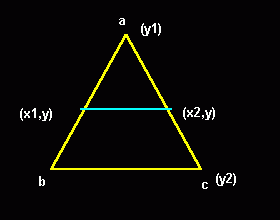
2. Flat Top
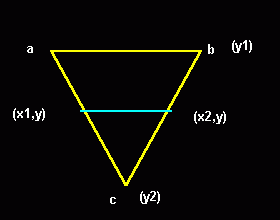
3. Generic
Triangle
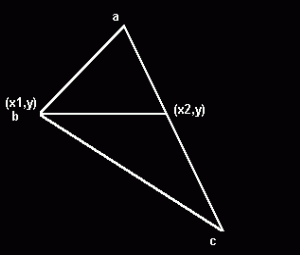
In both the Flat Top and
Flat bottom cases, it's easy to do both triangles as we only need to interpolate
A to B and A to
C in Y steps. We draw a horizontal line in between (x1,y) and
(x2,y).
The problem lies when we want to draw a generic
triangle since we don't know if it's a flat top or flat bottom. But it turns out
that there is an all too easy way to get around with this. Analyzing the generic
triangle, we could just divide the triangle into 2 triangles. One Flat Bottom
and One Flat Top!
We draw it with 2 loops.
The first loop is to draw the Flat Bottom and the second loop is for the Flat
Top.
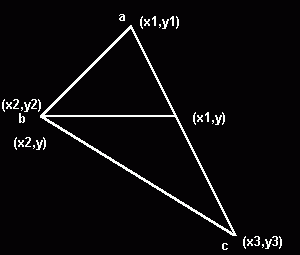
PseudoCode:
TOP PART ONLY!!!!(FLAT BOTTOM)
1. Interpolate a.x and draw each scanline from a.x to b.x in (b.y-a.y) steps.
ie. a.x = x3 - x1
b.x = y3 - y1
Xstep1! = a.x / b.x
2. Interpolate a.x and draw each scanline from a.x to c.x in (c.y-a.y) steps.
ie. a.x = x1 - x3
c.x = y1 - y3
Xstep3! = a.x / c.x
3. Draw each scanline(Horizontal line) from a.y to b.y incrementing y with one in each step, interpolating LeftX with Xstep1! and RightX with Xstep3!. You've just finished drawing the TOP part of the triangle!!!
4. Do the same with the bottom-half interpolating from b.x to c.x in b.y steps.
PseudoCode:
1. Sort Vertices
IF y2 < y1
THEN
SWAP y1, y2
SWAP x1,
x2
END IF
IF y3 < y1 THEN
SWAP y3,
y1
SWAP x3, x1
END IF
IF y3 < y2
THEN
SWAP y3, y2
SWAP x3, x2
END
IF
2.
Interpolate A to B
dx1 =
x2 - x1
dy1 = y2 - y1
IF dy1 <> 0
THEN
Xstep1! = dx1 /
dy1
ELSE
Xstep1! = 0
END
IF
3. Interpolate B
to C
dx2 = x3 -
x2
dy2 = y3 - y2
IF dy2 <> 0 THEN
Xstep2! = dx2 / dy2
ELSE
Xstep2! = 0
END
IF
4. InterPolate A
to C
dx3 = x1 -
x3
dy3 = y1 - y3
IF dy3 <> 0 THEN
Xstep3! =
dx3 / dy3
ELSE
Xstep3! = 0
END
IF
5. Draw Top
Part
Lx! = x1 'Starting
coords
Rx! = x1
FOR y = y1 TO y2 - 1
LINE (Lx!,
y)-(Rx!, y), clr
Lx! = Lx! + Xstep1! 'increment
derivatives
Rx! = Rx! + Xstep3!
NEXT
y
6. Draw Lower
Part
Lx! = x2
FOR
y = y2 TO y3
LINE (Lx!, y)-(Rx!, y),
clr
Lx! = Lx! + delta2!
Rx! = Rx! +
delta3!
NEXT y
Here's an example file:
B. Gouraud
Filled
There is not that much difference between the flat triangle and the gouraud triangle. In the calling sub, instead of just the 3 coodinates, there are 3 paramenters more. Namely: c1,c2,c3. They are the colors we could want to interpolate between vertices. And since you know how to interpolate already, it would not be a problem. :*)
First we need a horizontal line routine that draws with interpolated colors. Here's the code. It's self explanatory.
*dc! is the ColorStep(Like the Xsteps)
QBcode:
HlineG
(x1,x2,y,c1,c2)
dc! = (c2 - c1)/ (x2 -
x1)
c! = c1
For x = x1 to
x2
Pset(x , y) ,
int(c!)
c! = c! +
dc!
next x
Now that we have a horizontal gouraud line, we will modify some code into our flat filler to make it a gouraud filler. I won't give you the whole code, but some important snippets.
1. In the sorting stuff: (You have to do this to all the IF's.
IF y2 < y1
THEN
SWAP y1, y2
SWAP x1,
x2
SWAP c1, c2
END IF
2. Interpolate A to B; c1 to c2.
do this to all vertices.
dx1 = x2 - x1
dy1 = y2 -
y1
dc1 = c2 - c1
IF dy1 <> 0 THEN
Xstep1! = dx1 / dy1
Cstep1! = dc1 /
dy1
ELSE
Xstep1! = 0
Cstep1! =
0
END IF
5. Draw Top Part
Lx! = x1 'Starting
coords
Rx! = x1
Lc! = c1 'Starting colors
Rc! = c1
FOR y = y1 TO
y2 - 1
HlineG Lx!, Rx!, y, Lc!, Rc!
Lx! = Lx! + Xstep1!
Rx! = Rx! +
Xstep3!
Lc! = Lc! + Cstep1! 'Colors
Rc! = Rc! + Cstep3!
NEXT y
It's that easy! You have to interpolate just 3 more values! Here's the complete example file:
C. Affine
Texture Mapped
Again, there is not much difference between the previous 2 triangle routines from this. Affine texturemapping also involves the same algo as that of the flat filler. That is, Linear interpolation. That's probably why it doesn't look good. :*( But it's fast. :*). If in the gouraud filler you need to interpolate between 3 colors, you need to interpolate between 3 U and 3 V texture coordinates in the affine mapper. That's 6 values in all. In fact, it's almost the same as gouraud filler!
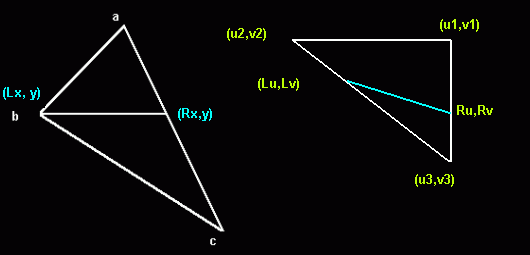
Now we have to modify our Gouraud Horizontal line routine to a textured line routine.
*This assumes that the
texture size is square and a power of 2. Ie. 4*4, 16*16, 128*128,etc. And is
used to prevent from reading pixels outside the texture.
*The texture mapper
assumes a QB GET/PUT compatible image. Array(1) = width*8; Array(2) = Height;
Array(3) = 2 pixels.
* HlineT also assumes that a DEF SEG = Varseg(Array(0))
has been issued prior to the call. TOFF is the Offset of the image in multiple
image arrays. ie: TOFF = VARPTR(Array(0))
*TsizeMinus1 is Texturesize
-1.
QBcode:
HlineT (x1,x2,y,u1,u2,v1,v2,Tsize)
du! = (u2 -
u1)/ (x2 - x1)
dv! = (v2 - v1)/ (x2 -
x1)
u! = u1
v! =
v1
TsizeMinus1 = Tsize - 1
For x
= x1 to x2
'get pixel off the
texture using
'direct memory read.
The (+4 + TOFF)
'is used to
compensate for image
'offsetting.
Tu=u! AND
TsizeMinus1
Tv=v! AND
TsizeMinus1
Texel = Peek(Tu*Tsize
+ Tv + 4 + TOFF)
Pset(x , y) ,
Texel
u! = u! +
du!
v! = v! +
dv!
next x
Now we have to modify the rasterrizer to support U and V coords. All we have to do is interpolate between all the coords and we're good to go.
1. In the sorting stuff:
(You have to do this to all the IF's.
IF y2 < y1 THEN
SWAP
y1, y2
SWAP x1, x2
SWAP u1,
u2
SWAP v1, v2
END IF
2. Interpolate A to B; u1 to u2; v1 to
v2. Do this to all vertices.
dx1 = x2 - x1
dy1 = y2 - y1
du1 = u2 -
u1
dv1 = v2 - v1
IF dy1 <> 0 THEN
Xstep1! = dx1 / dy1
Ustep1! = du1 /
dy1
Vstep1! = dv1 / dy1
ELSE
Xstep1! = 0
Ustep1! = 0
Vstep1! =
0
END IF
5. Draw
Top Part
Lx! =
x1 'Starting coords
Rx! = x1
Lu! = u1 'Starting U
Ru! = u1
Lv! = v1
'Starting V
Rv! = v1
FOR y = y1 TO y2 - 1
HlineT
Lx!, Rx!, y, Lu!, Ru!, Lv!, Rv!
Lx! = Lx! +
Xstep1!
Rx! = Rx! + Xstep3!
Lu! = Lu! + Ustep1! 'U
Ru! = Ru! +
Ustep3!
Lv! = Lv! + Vstep1! 'V
Rv! =
Rv! + Vstep3!
NEXT y
Here's the example demo for you to learn from. Be sure to check the algo as it uses fixpoint math to speed things up quite a bit. :*)
IV. Shading and Mapping Techniques
1. Lambert
Shading
So you want your cube filled and
lightsourced, but don't know how to? The answer is Lambert Shading. And what
does
Lambert shading use? The NORMAL. Yes, it's the cross-product thingy I
was writing about. How do we use the normal you say. First, you have a
filled cube composed of triangles (Polys), now we define a vector orthogonal to
that plane(Yep, the Normal) sticking out.
How do we
calculate normals? Easy, use the cross product!
PseudoCode:
1. For each
poly..
2. get poly's x, y and z
coords
3. define vectors from 3
coords
4. get the cross-product(our normal to a
plane)
5. Normalize your normal
QBcode:
FOR i = 1 TO
UBOUND(Poly)
P1 =
Poly(i).P1 'get poly
vertex
P2 =
Poly(i).P2
P3 =
Poly(i).P3
x1 =
Model(P1).x 'get
coords
x2 =
Model(P2).x
x3 =
Model(P3).x
y1 =
Model(P1).y
y2 =
Model(P2).y
y3 =
Model(P3).y
Z1 =
Model(P1).z
Z2 =
Model(P2).z
Z3 =
Model(P3).z
ax! = x2 -
x1 'derive
vectors
bx! = x3 -
x2
ay! = y2 -
y1
by! = y3 -
y2
az! = Z2 -
Z1
bz! = Z3 -
Z2
'Cross
product
xnormal! = ay! * bz! - az!
* by!
ynormal! = az! * bx! - ax! *
bz!
znormal! = ax! * by! - ay! *
bx!
'Normalize
Mag! = SQR(xnormal! ^ 2
+ ynormal! ^ 2 + znormal! ^ 2)
IF
Mag! <> 0
THEN
xnormal! = xnormal! /
Mag!
ynormal! = ynormal! /
Mag!
znormal! = znormal! / Mag!
END
IF
v(i).x = xnormal! 'this
is our face normal
v(i).y =
ynormal!
v(i).z =
znormal!
NEXT i
Q: "You expect me to do this is real-time?!!!" "That
square-
root alone would make my renders slow as hell!!"
A: No. You only
need to do this when setting up your renders.
ie. Only do this once, and at
the top of your proggie.
Now that we have our
normal, we define a light source. Your light source is also a vector. Be sure
that both vectors
are normalized.
ie.
Light.x\
Light.y > The light
vector
Light.z/
Polynormal.x\
Polynormal.y > The Plane
normal
Polynormal.z/

The angle in
the pic is the incident angle between the light and the plane
normal. the angle is inversely proportional to the
intensity of light. So the lesser the angle, the more intense the
light. But how do we get the intensity? Fortunately, there is an
easy way to calculate the light. All we have to do is get the Dot product
between these vectors!!! Since the dot returns a scalar value ,Cosine(angle), we
can get the brightness factor by just multiplying the Dot
product by the
color range!!! In screen 13: Dot*255.
QBCode:
nx! =
PolyNormal.x
ny! = PolyNormal.y
nz!
= PolyNormal.z
lx! = LightNormal.x
ly! = LightNormal.y
lz! =
LightNormal.z
Dot! = (nx! * lx!) + (ny! * ly!) + (nz! *
lz!)
IF Dot! < 0 then Dot! =
0
Clr = Dot! *
255
FlatTri x1, y1, x2, y2, x3,
y3, Clr
end if
Here's an example file in action:
Lambert.Bas
2. Gouraud Shading
After
the lambert shading, we progress into gouraud shading.Q: But how do we find a
normal to a point? A: You can't. There is no normal to a point. The
cross-product is exclusive to planes(3d) so you just can't. You don't have
to worry though, as there are ways around this problem.
What we need to do is to find adjacent faces that the vertex is located and average their face normals. It's an approximation but it works!
Let: V()= Face normal; V2()
vertexnormal
QBcode:
FOR i = 1 TO
Numvertex
xnormal! =
0
ynormal! =
0
znormal! =
0
FaceFound =
0
FOR j = 0 TO
UBOUND(Poly)
IF Poly(j).P1 = i OR
Poly(j).P2 = i OR Poly(j).P3 = i
THEN
xnormal! = xnormal! +
v(j).x
ynormal! = ynormal! +
v(j).y
znormal! = znormal! +
v(j).z
FaceFound = FaceFound + 1 'Face
adjacent
END
IF
NEXT j
xnormal! = xnormal! / FaceFound
ynormal! = ynormal! / FaceFound
znormal! = znormal! / FaceFound
v2(i).x = xnormal! 'Final vertex
normal
v2(i).y =
ynormal!
v2(i).z =
znormal!
NEXT i
Now that you have calculated the vertex normals, you only have to pass the rotated vertex normals into our gouraud filler!!! ie. Get the dot product between the rotated vertex normals and multiply it with the color range. The product is your color coordinates.
QBcode:
IF znormal < 0
THEN
nx1! = CubeVTXNormal2(Poly(i).P1).X
'Vertex1
ny1! =
CubeVTXNormal2(Poly(i).P1).Y
nz1! =
CubeVTXNormal2(Poly(i).P1).Z
nx2! =
CubeVTXNormal2(Poly(i).P2).X 'Vertex2
ny2! =
CubeVTXNormal2(Poly(i).P2).Y
nz2! =
CubeVTXNormal2(Poly(i).P2).Z
nx3! =
CubeVTXNormal2(Poly(i).P3).X 'Vertex3
ny3! =
CubeVTXNormal2(Poly(i).P3).Y
nz3! =
CubeVTXNormal2(Poly(i).P3).Z
lx! =
LightNormal.X
ly! = LightNormal.Y
lz! = LightNormal.Z
'Calculate dot-products of vertex
normals
Dot1! = (nx1! * lx!) + (ny1! * ly!) + (nz1! *
lz!)
IF Dot1! < 0 THEN
'Limit
Dot1! =
0
ELSEIF Dot1! > 1 THEN
Dot1! =
1
END IF
Dot2! = (nx2! * lx!) +
(ny2! * ly!) + (nz2! * lz!)
IF Dot2! < 0
THEN
Dot2! =
0
ELSEIF Dot2! > 1
THEN
Dot2! =
1
END IF
Dot3! = (nx3! * lx!) +
(ny3! * ly!) + (nz3! * lz!)
IF Dot3! < 0
THEN
Dot3! =
0
ELSEIF Dot3! > 1
THEN
Dot3! =
1
END IF
'multiply by color
range
clr1 = Dot1! * 255
clr2 =
Dot2! * 255
clr3 = Dot3! * 255
GouraudTri x1, y1, clr1, x2, y2, clr2, x3, y3, clr3
END IF
Here's and example file:
3. Phong Shading(Fake)
Phong shading is a shading technique which utilizes diffuse, ambient and specular lighting. The only way to do Real phong shading is on a per-pixel basis. Here's the equation:
Intensity=Ambient + Diffuse
* (L • N) + Specular * (R • V)^Ns
Where:
Ambient = This is the light intensity that the objects reflect upon the environment. It reaches even in shadows.
Diffuse = Light that scatters in all direction
Specular = Light intensity that is dependent on the angle between your eye vector and the reflection vector. As the angle between them increases, the less intense it is.
L.N = The dot product of the Light(L) vector and the Surface Normal(N)
R.V = The dot product of the Reflection(R) and the View(V) vector.
Ns = is the specular intensity
parameter, the greater the value, the more intense the specular light
is.
*L.N could be substututed to R.V which makes our equation:
Intensity=Ambient + Diffuse
* (L • N) + Specular * (L • N)^Ns
Technically, this should be done for every pixel of the polygon. But since we are making real-time engines and using QB, this is almost an impossibilty. :*(
Fortunately, there are some ways around this. Not as good looking but works nonetheless. One way is to make a phong texture and use environment mapping to simulate light. Another way is to modify your palette and use gouraud filler to do the job. How do we do it then? Simple! Apply the equation to the RGB values of your palette!!!
First we need to calculate the angles for every, color index in our pal. We do this by interpolating our Normals' angle(90 degrees) and Light vectors' angle with the color range.
PseudoCode:
Range = 255 - 0 'screen 13
Angle! = PI / 2 '90 degrees
Anglestep! = Angle!/Range 'interpolate
For Every color index...
Dot! = Cos(Angle!)
'''Apply equation
'RED
Diffuse! = RedDiffuse * Dot!
Specular! = RedSpecular + (Dot! ^Ns)
Red% = RedAmbient! + Diffuse! + Specular!
'GREEN
Diffuse! = GreenDiffuse * Dot!
Specular! = GreenSpecular + (Dot! ^Ns)
Green% = GreenAmbient! + Diffuse! + Specular!
'BLUE
Diffuse! = BlueDiffuse * Dot!
Specular! = BlueSpecular + (Dot! ^Ns)
Red% = BlueAmbient! + Diffuse! + Specular!
WriteRGB(Red%,Green%,Blue%,ColorIndex)
Angle! = AngleStep!
Loop until maxcolor
* This idea came from a Cosmox 3d demo by Bobby 3999. Thanks a bunch!
Here's an example file:
4. Texture Mapping
Texture mapping is a type of fill that uses a Texture(image) to fill a polygon. Unlike our previous fills, this one "plasters" an image(the texture) on your cube. I'll start by explaining what are those U and V coordinates in the Affine mapper part of the article. The U and V coordinates are the Horizontal and vertical coordinates of the bitmap(our texture). How do we calculate those coordinates? Fortunately, most 3d modelelers already does this for us automatically. :*).
However, if you like to make your models the math way, that is generating them mathematically, you have to calculate them by yourself. What I do is divide the quad into two triangles and blast the texture coordinates on loadup. Lookat the diagram to see what I mean.
*Textsize is the width or height of the bitmap
QBcode:
FOR j = 1
TO UBOUND(Poly)
u1 =
0
v1 =
0
u2 =
TextSize%
v2 =
TextSize%
u3 =
TextSize%
v3 =
0
Poly(j).u1 =
u1
Poly(j).v1 =
v1
Poly(j).u2 =
u2
Poly(j).v2 =
v2
Poly(j).u3 =
u3
Poly(j).v3 =
v3
j = j +
1
u1 =
0
v1 =
0
u2 =
0
v2 =
TextSize%
u3 =
TextSize%
v3 =
TextSize%
Poly(j).u1 =
u1
Poly(j).v1 =
v1
Poly(j).u2 =
u2
Poly(j).v2 =
v2
Poly(j).u3 =
u3
Poly(j).v3 =
v3
NEXT j
After loading the textures, you just call the TextureTri sub passing the right parameters and it would texture your model for you. It's a good idea to make a 3d map editor that let's you pass texture coordinates, instead of calculating it on loadup. Here's a code snippet to draw a textured poly.
QBcode:
u1 = Poly(i).u1 'Texture
Coords
v1 = Poly(i).v1
u2 = Poly(i).u2
v2 = Poly(i).v2
u3 =
Poly(i).u3
v3 = Poly(i).v3
TextureTri x1, y1, u1, v1, x2, y2, u2, v2, x3,
y3, u3, v3, TSEG%, TOFF%
END IF
*Tseg% and Toff% are the Segment and Offset of the Bitmap.
Here's an example file:
5. Environment Mapping
Environment mapping(also called Reflection Mapping) is a way to display a model as if it's reflecting a surface in front of it. Your model looks like a warped-up mirror! It looks so cool, I jumped off my chair when I first made one. :*) We texture our model using the texture mapper passing a vertex-normal modified texture coordinate. What does it mean? It means we calculate our texture coordinate using our vertex normals!
Here's the formula:
TextureCoord = Wid/2+Vertexnormal*Hie/2
Where:
Wid = Width of the bitmap
Hei = Height of the bitmap
Now, assuming your texture has the same width and height:
QBcode:
Tdiv2! = Textsize% /
2
FOR i = 1 TO UBOUND(Poly)
u1! = Tdiv2! +
v(Poly(i).P1).x * Tdiv2! 'Vertex1
v1! = Tdiv2! +
v(Poly(i).P1).y * Tdiv2!
u2! = Tdiv2! + v(Poly(i).P2).x *
Tdiv2! 'Vertex2
v2! = Tdiv2! + v(Poly(i).P2).y *
Tdiv2!
u3! = Tdiv2! + v(Poly(i).P3).x * Tdiv2!
'Vertex3
v3! = Tdiv2! + v(Poly(i).P3).y *
Tdiv2!
Poly(i).u1 = u1!
Poly(i).v1 =
v1!
Poly(i).u2 = u2!
Poly(i).v2 =
v2!
Poly(i).u3 = u3!
Poly(i).v3 =
v3!
NEXT i
After setting up the vertex normals and the texture coordinates, inside your rasterizing loop:
1. Rotate Vertex normals
2. Calculate texture coordinates
3. Draw model
That's it! Your own environment mapped rotating object. ;*)
Here's a demo:
Another one that simulates textures with phong shading using a phongmapped texture.
Playing with colors!!!
6. Shading in multicolor
Our previous shading techniques, Lambert, gouraud, and phong, looks good but you are limited to a single gradient. Not a good fact if you want to use colors. But using colors in screen 13 limits you to flat shading. I bet you would want a gouraud or phong shaded colored polygons right? Well, lo and behold! There is a little way around this problem. :*)
We use a subdivided gradient palette! A subdivided gradient palette divides your whole palette into gradients of colors limited to its subdivision. Here's a little palette I made using data statements and the gradcolor sub.

If you look closely, each line starts with a dark color and progresses to an intense color. And if you understood how our fillers work, you'll get the idea of modifying the fillers to work with this pal. Okay, since I'm feeling good today, I'll just give it to you. After you calculated the Dot-product between the light and poly normals:
*This assumes a 16 color gradient palette. You could make it 32 or 64 if you want. Of course if you make it 32, you should multiply by 32 instead of 16. :*)
QBcode:
Clr1 =
(Dot1! * 16) + Poly(j).Clr '16 color grad
Clr2 = (Dot2! *
16) + Poly(j).Clr
Clr3 = (Dot3! * 16) +
Poly(j).Clr
GouraudTri x1, y1, Clr1, x2, y2, Clr2, x3,
y3, Clr3
Here's an example:
7. Translucency
A lot of people have asked me about the algo behind my translucent teapot in Mono and Disco. It's not that hard once you know how to make a translucent pixel. This is not really TRUE translucency, It's a gradient-based blending algorithm. You make a 16 color gradient palette and apply it to the color range(Same grad above. :*)).
PseudoCode:
For Every pixel in the poly...
TempC = PolyPixel and 15
BaseColor = PolyPixel - TempC
DestC = Color_Behind_Poly_Pixel and 15
C = (TempC + DestC)/2
C = C + Basecolor
Pset(x,y),C
What this does for every pixel is to
average the polygons color with the color behind it(the screen or buffer) and
add it to the basecolor. The basecolor is the starting color for each
gradient. Ie. (0-15): 0 is the base color; (16 to 31): 16 is the base
color. Hence the AND 15. Of course, you can make it a 32 color gradient
and AND it by 31. :*)
Here's a little demo of Box translucency I
made for my Bro. Hex. ;*)
Here's the 3d translucency demo:
Final Words:
To make good models, use a 3d modeler and import it as an OBJ file as it's easy to read 3d Obj files. Lightwave3d and Milkshape3d can import their models in the OBJ format. In fact I made a loader myself. ;*) Note that some models does not have textures, notably, Ship.l3d, fighter.l3d, etc. The only ones with saved textures are Cubetext, Maze2, TriforcT, and Pacmaze2.
Zipped with OBJs:
Bas File:
This article is just a stepping stone for you into bigger things like Matrices, viewing systems and object handling. I hope you learned something from this article as this took me a while to write. Making the example files felt great though. :*) Any questions, errors in this doc, etc., you can post questions at http://forum.qbasicnews.com/. Chances are, I would see it there.
Next article, I will discuss Matrices and how to use them effectively on your 3d engine. I would also discuss polygon clipping and probably, if space permits, 3d viewing systems. So bye for now, Relsoft, signing off...
Credits:
God for making me a little healthier. ;*)
Dr. Davidstien for all the 3d OBJs.
Plasma for SetVideoSeg
Biskbart for the Torus
Bobby 3999 for the Phong sub
CGI Joe for the original polyfillers
Blitz for the things he taught me.
Toshi for the occasional help